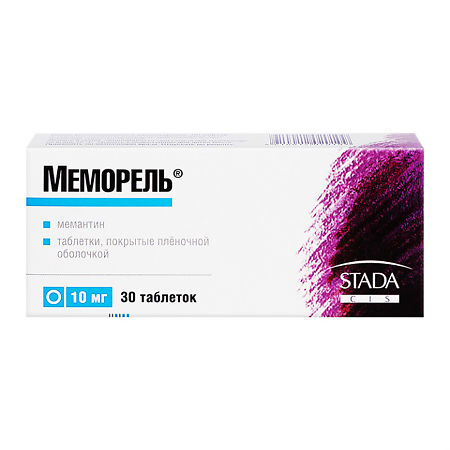No products in the cart.
Memorel, tablets 10 mg, 30 pcs.
€1.00
Out of stock
(E-mail when Stock is available)
Description
A glutamate NMDA receptor blocker. A drug for treatment of dementia. It has nootropic, cerebrovasodilatory, antihypoxic and psychostimulatory effects.
Adamantan derivative with chemical structure and pharmacological properties similar to amantadine.
Blocks glutamate N-methyl-D-aspartate (NMDA)-receptors (including in the substantia nigra), thereby reducing the overstimulating effect of cortical glutamate neurons on the neostriatum that develops in the background of insufficient dopamine release.
By reducing the supply of ionized calcium to neurons, it reduces the possibility of their destruction. To a greater extent affects stiffness (rigidity and bradykinesia).
In addition to action on the CNS, memantine affects efferent innervation.
It improves impaired memory and concentration, reduces fatigue and symptoms of depression, reduces spasticity of skeletal muscles caused by brain diseases and injuries, increases daily activity.
PHARMACOKINETICS
Intake
After oral administration, it is quickly and completely absorbed from the GI tract. Cmax reached after 3-8 h. Food intake does not affect absorption of the drug.
Distribution
The administration of the drug at a daily dose of 20 mg results in a Css of 70 to 150 mg/mL. Vd is about 10 l/kg. Binding to plasma proteins is 45%. No memantine cumulation is noted in normal renal function.
Metabolism
80% of circulating memantine in blood is represented by unchanged substance. Metabolism occurs without the participation of cytochrome P450.
The main metabolites are N-3,5-dimethylgludantane, an isomeric mixture of 4- and 6-hydroxymemantine and 1-nitroso-3,5-dimethyladamantane. None of the metabolites has antagonistic activity toward NMDA receptors.
Elimination
Elimination is mainly excreted by the kidneys. Excretion is single-phase, T1/2 is 60-100 h; clearance is 170 ml/min/1.73 m2, partially secreted by renal tubules. When the urine is alkaline, excretion of the drug slows down (on average 80% at urine pH 8).
Indications
Indications
Medium to severe dementia in Alzheimer’s disease.
Active ingredient
Active ingredient
Composition
Composition
How to take, the dosage
How to take, the dosage
Ingestion, regardless of meals.
In week 1, the daily dose is 5 mg (in the morning). In week 2, the daily dose is 10 mg (5 mg twice a day). During week 3, the daily dose is 15 mg per day (10 mg in the morning and 5 mg in the evening). From week 4, the daily dose is 20 mg per day. The maximum daily dose is 20 mg per day.
Dose adjustment in elderly patients (over 65 years) is not required.
In moderate renal failure (creatinine Cl 50-80 ml/min) dosage adjustment is usually not required; in creatinine Cl 30-49 ml/min the daily dose initially does not exceed 10 mg, then after 7 days with good tolerability the dose can be increased up to 20 mg.
In severe renal failure (creatinine Cl 5-29 ml/min) the daily dose should not exceed 10 mg.
In mild to moderate hepatic impairment (Child-Pugh class A and B), no dose adjustment is required.
Interaction
Interaction
In concomitant use may weaken the effect of barbiturates and neuroleptics.
The effects of baclofen and dantrolene may be altered by memantine, so doses may need to be adjusted.
When memantine is used concomitantly with levodopa drugs, dopamine agonists, anticholinergic agents the effects of the latter may be enhanced.
Because memantine and amantadine are NMDA receptor antagonists, concomitant use should be avoided due to the risk of developing toxic effects. Combinations of memantine with ketamine, dextromethorphan and phenytoin are also potentially toxic.
The same renal cation system is used to transport amantadine, cimetidine, ranitidine, quinidine, procainamide, quinine and nicotine in the body, which may cause interaction of these drugs with memantine, resulting in increased plasma concentrations.
When used concomitantly, memantine may cause a decrease in the serum concentration of hydrochlorothiazide.
Concomitant use with warfarin and other indirect anticoagulants requires close monitoring of prothrombin time and international normalized ratio.
Special Instructions
Special Instructions
Contraindications
Contraindications
With caution, use with thyrotoxicosis, epilepsy, seizures (including history of history), concomitant use of NMDA-receptor antagonists (amantadine, ketamine, dextromethorphan), factors that increase urine pH (i.e., urine acid). urinary pH-raising factors (sudden change of diet, heavy intake of alkaline gastric buffers), severe urinary tract infections, myocardial infarction (history), III-IV heart failure
with a history of myocardial infarction/p>
functional class (according to NYHA classification), uncontrolled arterial hypertension, in renal insufficiency, liver failure.
Side effects
Side effects
Overdose
Overdose
Symptoms: dizziness, tremor, agitation, drowsiness, confusion, agitation, stupor, seizures, aggressiveness, hallucinations, unsteady gait, vomiting, diarrhea.
Treatment: gastric lavage, administration of activated charcoal; symptomatic therapy. There is no specific antidote. Excretion of the drug may be accelerated by urine acidification.
Pregnancy use
Pregnancy use
The use of Memorel ® is contraindicated in pregnancy and lactation.
Memantine has the ability to slow down the development of the fetus.
Breastfeeding should be stopped during treatment with memantine.
Similarities
Similarities
Additional information
| Shelf life | 2 years. Do not use later than the date on the package. |
|---|---|
| Conditions of storage | In a dry, light-protected place at a temperature no higher than 25 degrees. Keep out of reach of children. |
| Manufacturer | Bilim Iliaç Sanayi ve Ticaret, Turkey |
| Medication form | pills |
| Brand | Bilim Iliaç Sanayi ve Ticaret |
Related products
Buy Memorel, tablets 10 mg, 30 pcs. with delivery to USA, UK, Europe and over 120 other countries.














